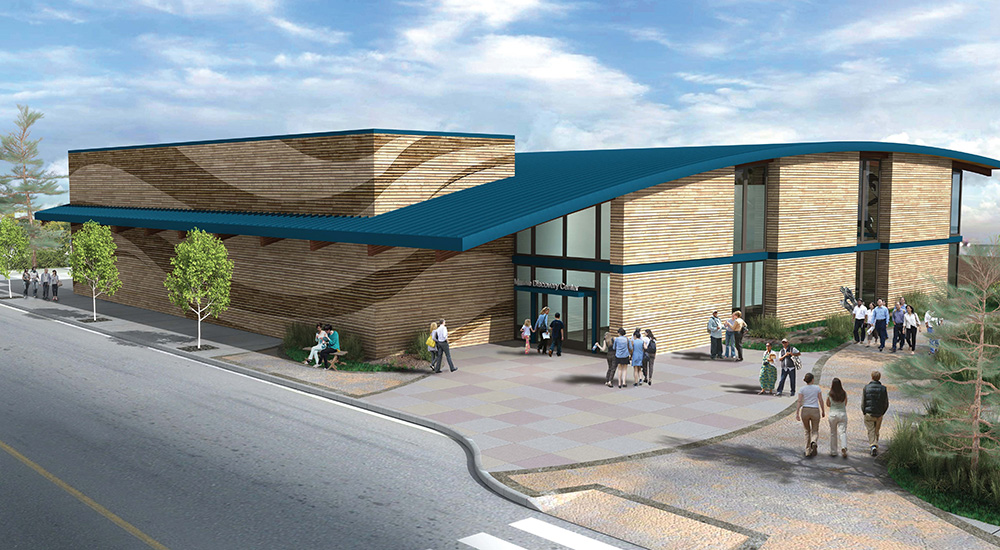NOAA announces $3 million to support construction of a new discovery center in Port Angeles for Olympic Coast National Marine Sanctuary
August 1, 2023
Contact: Sarah Marquis, sarah.marquis@noaa.gov, 949-222-2212

NOAA will invest $3 million from the Inflation Reduction Act at Olympic Coast National Marine Sanctuary to support the construction of a new marine discovery visitor center in Port Angeles, Washington. NOAA intends to collaborate with the Feiro Marine Life Center to make the visitor center a prominent feature of the new Port Angeles Waterfront Center campus. The campus is home to the recently-constructed Field Hall performing arts center, and is where the Elwha Klallam Tribe plans to develop a cultural center.
NOAA and the Feiro Marine Life Center have collaborated on the North Olympic Peninsula on education, stewardship and science for over 20 years. The new facility would enable both entities to improve and expand upon collaborative educational programs.
"NOAA's national marine sanctuaries facilities are a gateway to our greatest underwater treasures — and key to maintaining them," said U.S. Secretary of Commerce Gina Raimondo. "This investment in a new facility for the Olympic Coast National Marine Sanctuary builds on years of collaboration between NOAA and local partners to promote marine conservation and education, and it is a testament to President Biden's commitment to investing in America."
"Today's announcement underscores the significant commitment being made to protect our cherished marine sanctuaries against the growing impacts of climate change," said Congressman Kilmer (WA-06). "The allocation of funds for the Olympic Coast National Marine Sanctuary will go a long way in enhancing its programs and facilities while strengthening our community's resilience. I'm proud to stand alongside the Biden Administration in this effort, reinforcing our dedication to protecting Washington state's environment for generations to come."
"We have common interests and needs, and a shared facility will give our partnership room to grow and expand our services to Olympic Peninsula communities and visitors," said Kevin Grant, sanctuary superintendent. "Our longstanding collaboration allows us to achieve a greater impact than the sum of our respective parts."
The new interpretive center would help make the sanctuary more accessible to the community by providing a venue for public education, while also strengthening ties between NOAA, Port Angeles and the whole peninsula.
The Feiro Marine Life Center was built in 1981 through the efforts of the late Arthur D. Feiro, a former high school science teacher who recognized the value in having a place on the Port Angeles waterfront where children, local residents and thousands of annual summer visitors could experience and learn about the marine environment he so loved.
"The Feiro Marine Life Center was conceived as a laboratory space for the community college," said Melissa Williams, Feiro Marine Life Center executive director. "Since becoming a stand-alone non-profit facility in 2008, we have been searching for a way to make our financial and physical operations sustainable and to meet the education and animal care needs of the future. This collaboration will enable Art Feiro's legacy to live on on the Olympic Peninsula."
Olympic Coast National Marine Sanctuary was established in 1994 and includes 3,188 square miles of marine waters off the rugged Olympic Peninsula in Washington state. The sanctuary lies mostly within the Usual and Accustomed treaty fishing areas of the Hoh Tribe, Makah Tribe, Quileute Tribe and the Quinault Indian Nation. Habitats within the sanctuary range from intertidal coastal areas and towering kelp forests to deep-sea coral and sponge communities. Twenty-nine species of marine mammals and more than 100 bird species reside in or migrate through the sanctuary, and it contains some of the most productive habitats for fish in the world.
The sanctuary is part of America's National Marine Sanctuary system, a network of underwater areas encompassing more than 620,000 square miles of marine and Great Lakes waters. The network includes a system of 15 national marine sanctuaries and Papahānaumokuākea and Rose Atoll marine national monuments.
These investments are part of a $3.3 billion total investment from the Inflation Reduction Act that is enabling NOAA to build on its commitment to help Americans — including tribes and vulnerable populations — prepare, adapt and build resilience to weather and climate events; improve supercomputing capacity and research on weather, oceans and climate; strengthen NOAA's hurricane hunter aircraft and fleet; and replace aging NOAA facilities. Stay updated about NOAA's Inflation Reduction Act investments.

